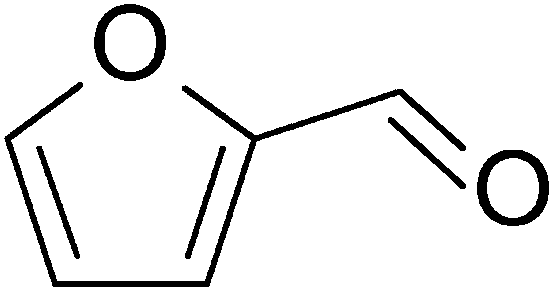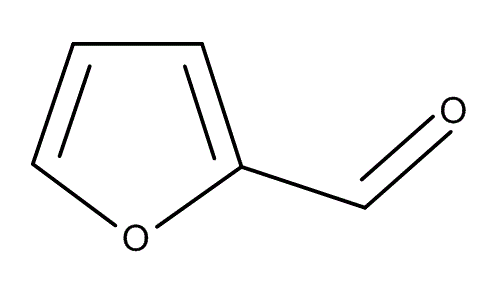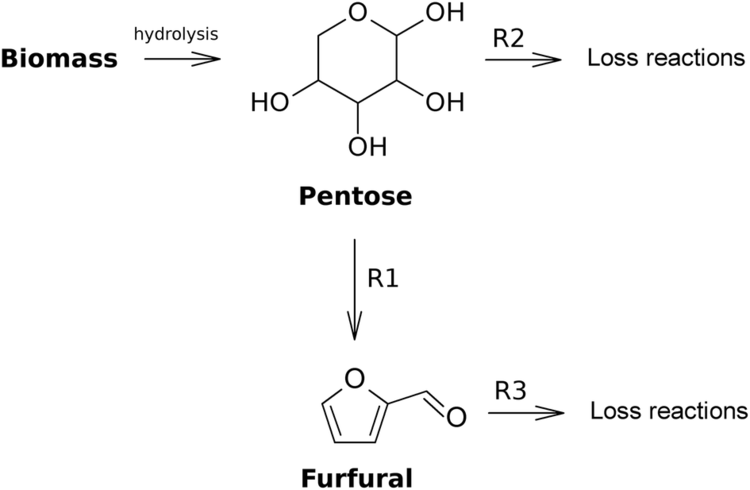Appearance Colorless oil Boiling point 161.7 °C Molar mass 96.09 g/mol | Formula C5H4O2 Density 1.16 g/cm³ | |
 | ||
Related furan-2-carbaldehydes | ||
Furfural
Furfural /ˈfɜːrfjᵿræl/ is an organic compound derived from a variety of agricultural byproducts, including corncobs, oat, wheat bran, and sawdust. The name furfural comes from the Latin word furfur, meaning bran, referring to its usual source.
Contents

Furfural is a heterocyclic aldehyde, with the ring structure shown at right. Its chemical formula is OC4H3CHO. It is a colorless oily liquid with the odor of almonds, which quickly darkens when exposed to air.

It is one of the components found in vanilla.
History

Furfural was first isolated in 1821 (published in 1832) by the German chemist Johann Wolfgang Döbereiner, who produced a small sample as a byproduct of formic acid synthesis. At the time, formic acid was formed by the distillation of dead ants, and Döbereiner's ant bodies probably contained some plant matter. In 1840, the Scottish chemist John Stenhouse found that the same chemical could be produced by distilling a wide variety of crop materials, including corn, oats, bran, and sawdust, with aqueous sulfuric acid, and he determined the empirical formula (C5H4O2). In 1901, the German chemist Carl Harries deduced furfural's structure.

Except for occasional use in perfume, furfural remained a relatively obscure chemical until 1922, when the Quaker Oats Company began mass-producing it from oat hulls. Today, furfural is still produced from agricultural byproducts like sugarcane bagasse and corn cobs. The main countries producing furfural today are the Dominican Republic, South Africa and China.
Properties

Furfural's physical properties are summarized in the table at top right. Furfural dissolves readily in most polar organic solvents, but is only slightly soluble in either water or alkanes.

Chemically, furfural participates in the same kinds of reactions as other aldehydes and other aromatic compounds. Indicating its diminished aromaticity relative to benzene, furfural is readily hydrogenated to the corresponding tetrahydrofuran derivatives. When heated in the presence of acids, furfural irreversibly solidifies, i.e. a thermosetting polymer .
Production
Furfural may be obtained by the acid catalyzed dehydration of 5-carbon sugars (pentoses), particularly xylose. These sugars may be obtained from hemicellulose present in lignocellulosic biomass (plant matter) and as such furfural may be considered a green chemical. This synthesis is similar to the production of hydroxymethylfurfural by the acid catalyzed dehydration of 6-carbon sugars (hexoses)
C5H10O5 → C5H4O2 + 3 H2OFor crop residue feedstocks, between 3% and 10% of the mass of the original plant matter can be recovered as furfural, depending on the type of feedstock. Furfural and water evaporate together from the reaction mixture, and separate upon condensation. The global production capacity is about 800,000 tons as of 2012. China is the biggest supplier of furfural, and accounts for the greater part of global capacity. The other two major commercial producers are Illovo Sugar in the Republic of South Africa and Central Romana in the Dominican Republic.
In the laboratory, synthesis of furfural from corn cobs takes place by reflux with dilute sulfuric acid.
The lignocellulosic residue that remains after the removal of the furfural is used to generate all the steam requirements of the furfural plant. Newer and more energy efficient plants have excess residue, which is or can be used for co-generation of electricity, cattle feed, activated carbon, mulch/fertiliser, etc.. It also has been used as a glue extender in the North American board industry.
Uses
Furfural is an important renewable, non-petroleum based, chemical feedstock. Hydrogenation of furfural provides furfuryl alcohol (FA) which is a useful chemical intermediate in for example the manufacture of furan resin prepolymers exploited in thermoset polymer matrix composites, cements, adhesives, casting resins and coatings. Further hydrogenation of furfuryl alcohol leads to tetrahydrofurfuryl alcohol (THFA) which is used as a nonhazardous solvent in agricultural formulations and as an adjuvant to help herbicides penetrate the leaf structure. Furfural is used to make other furan chemicals, such as furoic acid, via oxidation, and furan itself via palladium catalyzed vapor phase decarbonylation. Furfural is also an important chemical solvent.
Furfural was used as a fuel dye for all heating fuel for tax purposes in Finland before being replaced in 31.8.2003 by Solvent Yellow 124 due to EU legislation.
Safety
Although it occurs in many foods and flavorants, furfural is toxic with an LD50 of 65 mg/kg (oral, rat). It is a skin irritant and chronic skin exposure can lead to a skin allergy as well as an unusual susceptibility to sunburn.
The Occupational Safety and Health Administration has set a permissible exposure limit for furfural at 5 ppm over an eight-hour time-weighted average, and also designates furfural as a risk for skin absorption.
